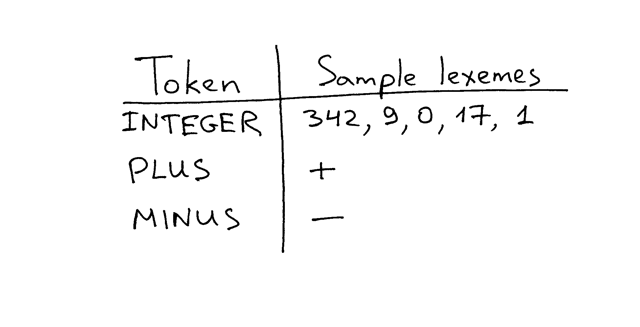Burger和Starbird合著过一本书《高效思考的五个要点》,里面提到Tony Plog,他是个吹喇叭的艺术家,开办了一个喇叭培训班。他班上都是成熟的喇叭演奏手。当这些演奏手吹奏复杂的歌曲的时候,吹的很精彩,但是当Tony让他们吹奏简单的音节的时候,听起来就很不成熟,甚至幼稚。Tony结果喇叭也吹了一次,听起来依然很成熟。众人惊诧不已。Tony解释说,吹好复杂的曲子容易,吹好简单的音节却很难,因为它要求吹奏的人对气息的控制力要非常强才可以。这给了我一个启发:构造足够复杂的系统,比如要聚焦在精通简单和基本的元素上。
是的,即使有时候你觉得花功夫在简单的事儿上,好像是退步一样。同样的道理,熟练地使用一个工具或者一个框架很重要,但是,懂得它们背后的原理更重要。正像Ralph Waldo Emerson说的:
”如果仅仅学会了一些方法,那你就会依赖它们解决遇到的每一个问题。但如果学会了方法背后的原理,你就是创造出自己的方法。“
回到interpreter和compiler上来,这一节我会带着你完善第一节的程序,让interpreter可以:
- 处理空白字符
- 处理多位数
- 支持减法操作
代码如下:
# Token types
# EOF (end-of-file) token is used to indicate that
# there is no more input left for lexical analysis
INTEGER, PLUS, MINUS, EOF = 'INTEGER', 'PLUS', 'MINUS', 'EOF'
class Token(object):
def __init__(self, type, value):
# token type: INTEGER, PLUS, MINUS, or EOF
self.type = type
# token value: non-negative integer value, '+', '-', or None
self.value = value
def __str__(self):
"""String representation of the class instance.
Examples:
Token(INTEGER, 3)
Token(PLUS '+')
"""
return 'Token({type}, {value})'.format(
type=self.type,
value=repr(self.value)
)
def __repr__(self):
return self.__str__()
class Interpreter(object):
def __init__(self, text):
# client string input, e.g. "3 + 5", "12 - 5", etc
self.text = text
# self.pos is an index into self.text
self.pos = 0
# current token instance
self.current_token = None
self.current_char = self.text[self.pos]
def error(self):
raise Exception('Error parsing input')
def advance(self):
"""Advance the 'pos' pointer and set the 'current_char' variable."""
self.pos += 1
if self.pos > len(self.text) - 1:
self.current_char = None # Indicates end of input
else:
self.current_char = self.text[self.pos]
def skip_whitespace(self):
while self.current_char is not None and self.current_char.isspace():
self.advance()
def integer(self):
"""Return a (multidigit) integer consumed from the input."""
result = ''
while self.current_char is not None and self.current_char.isdigit():
result += self.current_char
self.advance()
return int(result)
def get_next_token(self):
"""Lexical analyzer (also known as scanner or tokenizer)
This method is responsible for breaking a sentence
apart into tokens.
"""
while self.current_char is not None:
if self.current_char.isspace():
self.skip_whitespace()
continue
if self.current_char.isdigit():
return Token(INTEGER, self.integer())
if self.current_char == '+':
self.advance()
return Token(PLUS, '+')
if self.current_char == '-':
self.advance()
return Token(MINUS, '-')
self.error()
return Token(EOF, None)
def eat(self, token_type):
# compare the current token type with the passed token
# type and if they match then "eat" the current token
# and assign the next token to the self.current_token,
# otherwise raise an exception.
if self.current_token.type == token_type:
self.current_token = self.get_next_token()
else:
self.error()
def expr(self):
"""Parser / Interpreter
expr -> INTEGER PLUS INTEGER
expr -> INTEGER MINUS INTEGER
"""
# set current token to the first token taken from the input
self.current_token = self.get_next_token()
# we expect the current token to be an integer
left = self.current_token
self.eat(INTEGER)
# we expect the current token to be either a '+' or '-'
op = self.current_token
if op.type == PLUS:
self.eat(PLUS)
else:
self.eat(MINUS)
# we expect the current token to be an integer
right = self.current_token
self.eat(INTEGER)
# after the above call the self.current_token is set to
# EOF token
# at this point either the INTEGER PLUS INTEGER or
# the INTEGER MINUS INTEGER sequence of tokens
# has been successfully found and the method can just
# return the result of adding or subtracting two integers,
# thus effectively interpreting client input
if op.type == PLUS:
result = left.value + right.value
else:
result = left.value - right.value
return result
def main():
while True:
try:
# To run under Python3 replace 'raw_input' call
# with 'input'
text = raw_input('calc> ')
except EOFError:
break
if not text:
continue
interpreter = Interpreter(text)
result = interpreter.expr()
print(result)
if __name__ == '__main__':
main()可以自己试一下程序看看有没有问题
$ python calc2.py
calc> 27 + 3
30
calc> 27 - 7
20
calc>这一版主要的改动包括:
- get_next_token 方法被重构了一点点。pos指针自增的逻辑被重构成了一个方法,叫advance。
- 新增加了两个方法:skip_whitespace 用来忽略空白字符,integer 用来处理多位数。
- expr 方法也被改了,可以同时识别INTEGER -> MINUS -> INTEGER 和 INTEGER -> PLUS -> INTEGER 这两个串。.
第一章介绍过 token 和 词法分析器了,这一章我要谈谈词位(lexeme)、解析和解析器。
为了更好的理解token,词位这个概念躲不开。词位指的是一系列字符串,用来组成token。下图可以帮助理解。

还记得我们的老朋友—— expr 方法吗?他用来识别和解释算术表达式,得到正确的结果。想识别表达式,首先他就要做到识别短语,是加,还是减。对,这真是我们的老朋友的职责所在,他通过get_next_token得到token的序列,进而得知token序列的结构,按照结构来计算,最后得到计算结果。
得知token序列的结构,或者说识别token序列中的不同短语,这个过程就是解析。这部分interpreter和compiler的组成模块叫解析器。
具体说我们的老朋友吧,expr 方法首先解析 INTEGER -> PLUS -> INTEGER 或者INTEGER -> MINUS -> INTEGER 这些短语,解析成功任何一个以后,他就开始解释(interpret)它,并计算出结果。